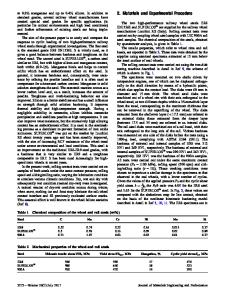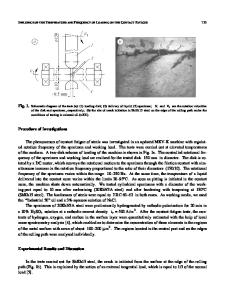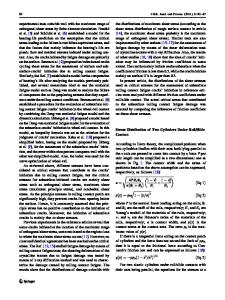Influence of the Inclusion Shape on the Rolling Contact Fatigue Life of Carburized Steels
- PDF / 930,991 Bytes
- 10 Pages / 593.972 x 792 pts Page_size
- 73 Downloads / 350 Views
N
RECENTLY, there is an increasing demand for reduction of CO2 emission to protect the environment. To solve the problem for CO2 emission, it is important for steel products to be energy saving, compact, and lightweight. Bearings are one of the automotive parts subjected to rolling and sliding contact under high loaded conditions. To realize the need to be compact and lightweight, the fatigue strength of bearings, especially rolling contact fatigue (RCF) strength, must be improved. It has been well known that the flaking failure in RCF originates from nonmetallic inclusions in steels,[1] and the oxide inclusions are harmful to the RCF life.[2–9] Therefore, many studies[10–17] have been carried out to clarify the effect of oxide size,[10,11] oxide composition,[12–14] and matrix–oxide interface condition[2,14–16] on RCF life. For example, Nagao et al.[17] studied the relationship between the RCF life and the maximum inclusion square root area calculated by the statistics of extreme value. They suggested that the calculated maximum inclusion size was the dominant factor in the RCF life regardless of the inclusion type. Hashimoto et al.[15] investigated the relationship between the RCF life and the oxide composition and matrix–oxide interface condition. They indicated that the oxide inclusion/matrix
YUTAKA NEISHI, TAIZO MAKINO, and NAOKI MATSUI, Senior Research Engineers, are with the Corporate Research & Development Laboratories, Sumitomo Metal Industries, Ltd., Amagasaki, Hyogo 660-0891, Japan. Contact e-mail: [email protected] HITOSHI MATSUMOTO, Group Manager, MASASHI HIGASHIDA, Assistant Manager, and HIDETAKA AMBAI, Research Engineer, are with the Products Development Department, Kokura Steel Works, Bar & Wire Rod Company, Sumitomo Metal Industries, Ltd. Manuscript submitted April 13, 2012. Article published online August 15, 2012 METALLURGICAL AND MATERIALS TRANSACTIONS A
interface cavities were created during plastic deformation, and the fatigue crack was initiated from the cavities at the early stage of RCF life due to the local stress magnitude induced around the oxide inclusion/matrix interface enlarged. According to the previous results, the RCF life was improved by reducing the oxide size and the cavities, and by tuning the chemical composition of oxide. In the RCF life of a material containing similar sized oxide, the chemical composition is the more affecting factor. Moreover, many finite elements models for material fatigue localized around inclusions have been developed to make clear the quantitatively effect of material parameter on the crack initiation and propagation in rolling contact.[18–24] Based on these results, the total amount of oxygen content in steels for bearing use has been reduced remarkably by improvements in steel production processes. As a consequence, the quality of cleanliness for the bearing steel has been improved, and the RCF life of steels has been prolonged every year. On the other hand, decreasing the amount of oxide in steel has caused another problem in which anothe
Data Loading...











